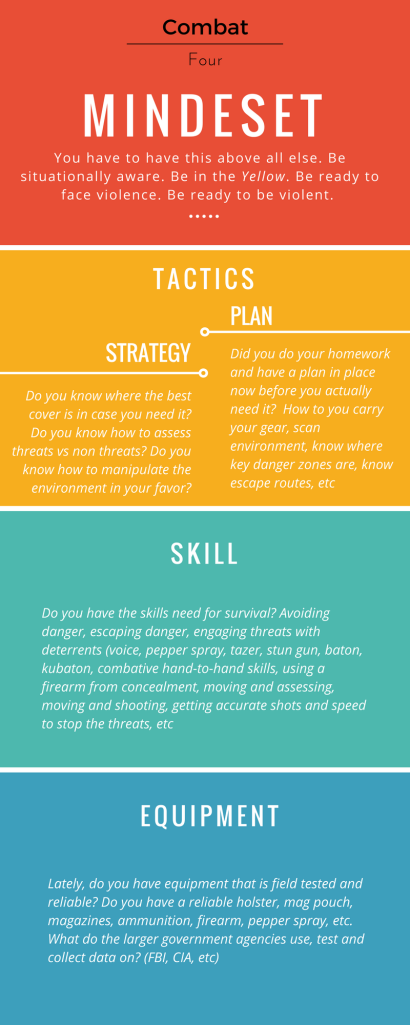April 24-25, 2017
I was recently invited (husband got to come along too) to Jeff Mau’s Tenicor Fundamentals course.
Here is what was covered in the class.
He emphasized that we all learn from those that came before us and that they have value. Knowledge and skills evolve as time passes and each instructor has value. We may not be in a place to fully understand or absorb the content in a class, especially one that is packed with information and we may not be mentally mature enough to assimilate the information until later in our skill development. Then you have that ‘A-ha’ moment.
Day one started with fundamental concepts.
Mindset, Tactics, Skill and Equipment.

Universal Gun Safety Rules. Let’s see if you can recite them:
It’s more than just reciting the rules. We need to internalize them and apply them to in context. These rules matter. Violate multiple rules and things go wrong. They have to make sense to you in all environments all the time.
Jeff went on to cover: stance, grip, and trigger press. He showed us the isosceles stance and mentioned that the Weaver stance had a purpose and it’s good to know different stances to add to your repertoire.
We did watch this old video of Jack Weaver talking about how he came about the stance. The Real Weaver Shooting Stance.
As far as stance, grip, trigger press, sight alignment, sight picture…your best option is to set up a lesson with me so that I can you show you key aspects to improve your marksmanship and speed skills.
Why do we get a gun? Various reasons from occupation, defensive, sport, hunting or collecting. What also determines gun selection and purchase?
- Reliability
- Accuracy
- Durability
- Usability
- Price
- Stopping power
- Ergonomics
- Size/Weight
- Capacity
- Interchangeability
- Material use in fabrication
Full size guns offer more accuracy then smaller frames.
How do you know if a gun is reliable? Asking 10 different people and you’ll get 10 different answers. The best place to put judgement on is by looking at what large government agencies have adopted. They test, re-test, collect data and publish findings. The FBI is such an organization to look at to see what firearms they have selected and why. Here are some:
- Glock 19
- Glock 17
- Glock 34
- Sig Sauer
- Beretta
- CZ
- HK
We also got into the Lethal Use of Force. A, O, J, P. Let me know if you need help with the abbreviation. He went on to mention the force hierarchy starting at the lease intrusive of presence up to the use of lethal force. If you are to carry concealed, are you mentally prepared to balance your moral compass vs legal justification for stopping a threat, which means you grave bodily injury or death?
 However…. that process might take too much time and leave you in a position on grave threat. In the book Left of Bang they suggest you ask the question of “should I use lethal force?” first and then work down from there. The moment of hesitation can cost you dearly.
However…. that process might take too much time and leave you in a position on grave threat. In the book Left of Bang they suggest you ask the question of “should I use lethal force?” first and then work down from there. The moment of hesitation can cost you dearly.
As a carry concealed citizen, you should know your local and state laws regarding self-defense. I’ll be re-taking MAG-40 this summer, I realize that in the moment of protecting my life that I cannot hesitate in my decisions. I have to have a plan today of where the line is in the sand for me to take action to save my life and be able to justifiably explain my actions when required.
We went on to cover skill development and then task layering plus a slight increase in added stress by shooting with a time limit on the range.
Eventually Jeff went into the construction of holsters plus the pros and cons. Mass productions companies make holsters because they are easy to manufacture and have universal parts however they don’t always work with a person’s needs/body shape nor easily concealable. How are they molded? How may ‘parts’ on the holster? If one fails then the holster is no longer useable. How far or close in to the body is it? Easy to conceal? How does the holster secure to the belt? (loops, clips?)
Gun belts are as important in your gear selection. Stiff enough to support gear and properly draw. Some belts he mentioned where Ares, Nexbelt, Grip6, and Kramer.
I got to wear Jeff’s ARX holster for my Glock 17 and his mag pouch for the course. The holster was snug to the body and very streamline. The one noticeable thing that my husband and I appreciate and noticed is that unlike other kydex type holsters, it is silent and doesn’t have the noticeable ‘click’ sound. The Fero mag pouch is also very streamline making it very concealable. I will be test driving it more during my practice sessions. With that said, my main daily carry mode, defensive training and competition is with an inside the waistband holster.
In summary, this was a great course and I would recommend it to everyone. As an experienced shooter I was able re-visit a lot of the concepts that I learned and have a new perspective provided on some of it, and a fresh set of eyes watching me shoot looking for subtle improvements. As a new shooter you will be exposed to a broad spectrum of ideas, many you may not have even considered before. My husband took the whole class shooting left handed ( he normally shoots right handed) and said it was great to have the chance to do a lot of structured drills starting from the ground up to develop his left handed capabilities. – #tenicorusa #tenicor














Leave a comment